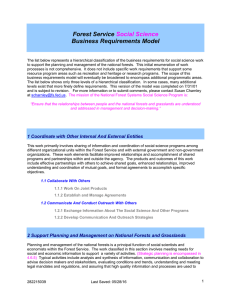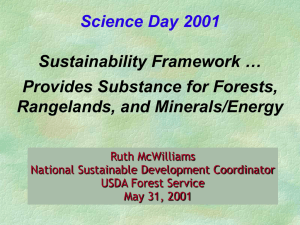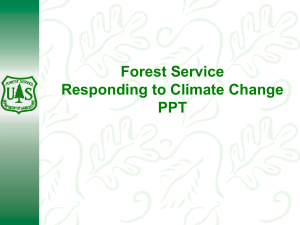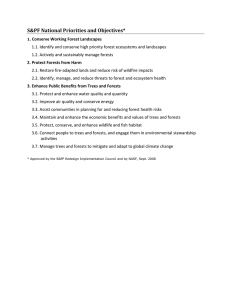Proposed Purpose, Goals, and Principles for Inclusion in the Federal Regulations
advertisement
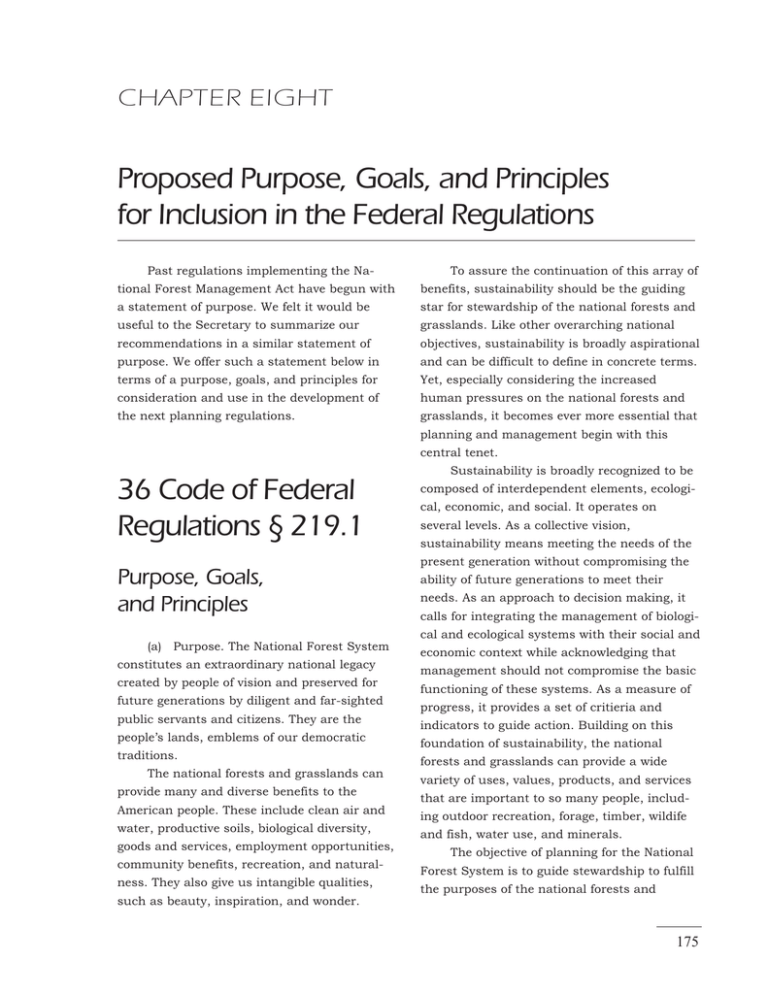
CHAPTER EIGHT Proposed Purpose, Goals, and Principles for Inclusion in the Federal Regulations Past regulations implementing the Na- To assure the continuation of this array of tional Forest Management Act have begun with benefits, sustainability should be the guiding a statement of purpose. We felt it would be star for stewardship of the national forests and useful to the Secretary to summarize our grasslands. Like other overarching national recommendations in a similar statement of objectives, sustainability is broadly aspirational purpose. We offer such a statement below in and can be difficult to define in concrete terms. terms of a purpose, goals, and principles for Yet, especially considering the increased consideration and use in the development of human pressures on the national forests and the next planning regulations. grasslands, it becomes ever more essential that planning and management begin with this central tenet. Sustainability is broadly recognized to be 36 Code of Federal Regulations § 219.1 composed of interdependent elements, ecological, economic, and social. It operates on several levels. As a collective vision, sustainability means meeting the needs of the present generation without compromising the Purpose, Goals, and Principles ability of future generations to meet their needs. As an approach to decision making, it calls for integrating the management of biological and ecological systems with their social and (a) Purpose. The National Forest System constitutes an extraordinary national legacy created by people of vision and preserved for future generations by diligent and far-sighted public servants and citizens. They are the people’s lands, emblems of our democratic traditions. The national forests and grasslands can provide many and diverse benefits to the American people. These include clean air and water, productive soils, biological diversity, goods and services, employment opportunities, community benefits, recreation, and naturalness. They also give us intangible qualities, economic context while acknowledging that management should not compromise the basic functioning of these systems. As a measure of progress, it provides a set of critieria and indicators to guide action. Building on this foundation of sustainability, the national forests and grasslands can provide a wide variety of uses, values, products, and services that are important to so many people, including outdoor recreation, forage, timber, wildife and fish, water use, and minerals. The objective of planning for the National Forest System is to guide stewardship to fulfill the purposes of the national forests and such as beauty, inspiration, and wonder. 175 grasslands and to honor their unique place in water purity, air quality, soil fertility, fire and American life. The regulations in this subpart flow regimes, plant growth, and the variety and set forth a process for developing, adopting, distribution of forests and rangelands. By implementing, and revising land- and resource- seeking to sustain biological diversity and management plans for the National Forest ecological productivity by first emphasizing System as required by the National Forest what we leave before we consider what we Management Act of 1976 (hereafter, “NFMA”), the take, forest planning can play a crucial role in Forest and Rangeland Renewable Resources Act laying the necessary foundation for the eco- of 1974, the Organic Act of 1897, the Multiple- nomic and social components of sustainability: Use, Sustained-Yield Act of 1960, the Endan- making contributions to strong, productive gered Species Act of 1973, the Clean Water Act of economies and creating opportunities for 1977, and other applicable statutes. enduring human communities. At the same (b) Major Goals and Principles. Land- and time, planning recognizes that ecological, resource-management planning shall strive to economic, and social sustainability are inextri- achieve the following major goals and embody cably linked; impairing the sustainability of the following principles. any one aspect affects the entirety. Goal One. Planning strives to assure the ecological sustainability of our watersheds, forests, and rangelands. Principles (a) Planning first provides for the diversity of plant and animal communities and the produc- The benefits we seek from the national tive capacity of ecological systems, the core forests and grasslands depend upon the long- elements of ecological sustainability. Biological term ecological sustainability of the water- diversity and ecological productivity, in turn, sheds, forests, and rangelands. Considering depend on the viability of individual species. the increased human pressures on them, it Diversity is sustained only when species per- becomes ever more essential that planners sist. In addition, biological diversity and ecologi- focus on the heart of the idea of sustainability, cal productivity depend on maintaining the that our use today does not impair the func- characteristic composition, structure, and tioning of ecological processes and the ability processes of ecosystems in the presence of of these natural resources to contribute eco- human and natural disturbances, on maintain- nomically and socially in the future. Accord- ing the ecological integrity of these systems. ingly, the first priority for stewardship in the (b) Planning must be based on science and national forests and grasslands must be to other knowledge of the world, including the use maintain and restore the ecological of scientifically based strategies for sustainability of watersheds, forests, and sustainability. The best available ecological, rangelands for present and future generations. economic, and social information and analysis While one function of the pursuit of must be the foundation of land- and resource- sustainability is to chart a broad and idealistic management planning. Planning should con- objective, important aspects of sustainability sider information from a wide range of sources, can also be defined and measured with some including scientists in public and private precision in the planning process. First, organizations as well as other knowledgeable species viability, which is essential to ecologi- people in tribes and local communities. cal sustainability, is a powerful metric. Second, (c) Planning requires independent scientific useful measurements can be made of ecologi- review of assessments and plans before their cal productivity through such indicators as publication. Regional assessments should 176 suggest methods and strategies for providing Principles for species viability and ecological integrity. With that information, planning should con- (a) Planning needs to recognize the interde- struct conservation strategies and have them pendence of forests, rangelands, and water- reviewed for accuracy and sufficiency by Forest sheds with economies and communities. Many Service and other scientists before a plan communities depend on the national forests becomes final. and grasslands for much of their economic, (d) Plans include measures for evaluating social, and cultural sustenance. Although the whether stewardship goals have been achieved. Forest Service cannot and should not be Because one of the core functions of planning expected to single-handedly sustain existing is to foster informed management decisions economies and communities, the national through ongoing assessment and evaluation, forests and grasslands nonetheless contribute effective monitoring is a crucial aspect of many values, services, outputs, and uses that planning and management. Additionally, allow economies and communities to persist, independent field review by Forest Service and prosper, and evolve according to their own outside technical and scientific experts plays wills. This charge, contributing to the well- an important role in monitoring the contribu- being of people today and tomorrow, is at the tion of plans to the sustainability of our for- heart of the Forest Service’s role in economic ests, streams, and watersheds. and social sustainability. Within a context of sustaining ecological systems, planning must Goal Two. Planning promotes economic and social sustainability by providing for a wide variety of uses, values, products, and services and by enhancing society’s capability to make sustainable choices. take generous account of compelling local circumstances. This approach includes the needs of ranching, farming, timber, and mining communities as well as Indian communities relying upon treaty obligations and Hispanic communities depending on the resources in The national forests and grasslands have been a grand experiment in providing for the former Spanish and Mexican land grants. (b) Planning fosters a broad-based under- multiple uses (outdoor recreation, forage, standing of the vital interrelationship between timber, wildlife and fish, water use, and miner- communities and sustainably managed forests als) of these lands on a permanent basis, and grasslands. It provides mechanisms following Gifford Pinchot’s dictates that the through which communities can organize their lands be devoted to “their most productive use energies and enterprises in a manner that for the permanent good of the whole people ... promotes economic and social sustainability always bearing in mind that the conservative and develop realistic expectations about long- use of these resources in no way conflicts with term uses, values, outputs, and services con- their permanent value.” The planning and tributed by the national forests and grasslands. management of these lands should be for the (c) Planning searches for strategies and entire world a shining example of stewardship actions that provide for human use in ways that that provides a wide variety of uses, values, contribute to long-term sustainability. Finding products, and services in ways that are com- strategies and actions that contribute to long- patible with long-term ecological, economic, term sustainability, rather than work against and social sustainability. it, is the surest way to increase the predictability of these uses. (d) Planning recognizes the rights of American Indian Tribes. Indian tribes possess 177 unique and important rights recognized by scape in which the national forests and grass- federal treaties, statutes, and executive orders. lands lie. And it must achieve the highest The agency has a general trust responsibility to values in managing these lands within the federally recognized tribes and a duty to ac- context of how people, businesses, and govern- knowledge them as sovereign governments and ments will conserve, regulate, and use the to work with them on a government-to-govern- lands within and around the national forests ment basis. Depending on the circumstances of and grasslands. particular tribes and national forests, such lands also may provide for tribal hunting, Principles fishing, and gathering rights; access to sacred sites; protection of graves and other archaeo- (a) Assessment and planning require a logical sites; watershed protection for down- coordinated approach by all affected federal stream Indian reservations; and fishing sites. agencies. Cooperation from the beginning with all federal agencies with statutory authority Goal Three. Planning recognizes and is efficiently integrated into the broader geographic, legal, political, and social landscape within which national forests and grasslands exist. over the national forests and grasslands is essential. Obtaining early participation of, and joint planning with, all federal land-management agencies in the area is another key to successful planning. While the Forest Service cannot require participation and joint planning In every sector of the country, the Forest Service and the national forests and grasslands are just one important agency and one with other federal agencies, the agency should seek and actively encourage it. (b) Planning proceeds from start to finish in important land system among many important close cooperation with state, tribal, and local governmental and private entities and land governments. Success in achieving goals for ownerships. Some of these agencies have the national forests and grasslands may statutory authority over the national forests. depend upon decisions made by other jurisdic- Other agencies, governments, corporations, tions. Similarly, the Forest Service often can and citizens manage land in and around the help other jurisdictions achieve their objectives national forests. Still others have a keen through cooperation. interest in the national forests and can affect (c) Planning is interdisciplinary. Planning the way the political process views Forest must respond to a broad range of scientific, Service action. economic, and social concerns. Therefore, Sustainability of watersheds and other planning teams must represent diverse disci- natural areas in which national forests and plines and work together collectively and grasslands are located will inevitably depend collegially to develop information and alterna- upon activities on nearby federal lands, tribal tives. Consultants can be employed to tap and state lands, and private lands and on the other relevant sources of knowledge. actions and attitudes of a wide variety of (d) Planning must be based on the spatial agencies, governments, and citizens. These and temporal scales necessary to assure landowners will vary in their abilities as well as sustainability and provide for multiple use. their interest in providing the mix of uses, Ecological boundaries that also have social products, values, and services that people seek meaning, such as river basins and mountain from forests and rangelands. Planning, there- ranges, will be useful for planning in the fore, must be outward-looking. It must have future. These planning boundaries often do not the goal of understanding the broader land- follow the boundaries of the national forests 178 and grasslands. To achieve long-term sustain- help the American people learn about the ability, planning must often take account of limits and capabilities of the national forests cumulative effects on resources within and and grasslands, so too must the managers be beyond the boundaries of the national forests educated by the unique knowledge, advice, and and grasslands and well beyond the life of values of the American people. Citizens can a plan. provide a wide array of services, ranging from (e) Planning recognizes the regional, volunteer work on trail crews to participating national, and global implications of manage- in collaborative efforts aimed at resolving ment. Assessment and planning should ac- disputes over specific projects. The Forest knowledge how management of the national Service should draw on this knowledge, wis- forests and grasslands can contribute to dom, and energy by building relationships, ecological, economic, and social sustainability dialogues, and partnerships with the groups on regional, national, and international scales. and individuals who wish to have a role in Often, federal lands will need to anchor re- setting the future course for the national gional and national conservation strategies for forests and in implementing these decisions. species and ecosystems so other landowners can continue production of goods and services Principles without undue restriction. In addition, the wood, water, and recreation they provide are (a) Planning encourages extensive collabo- often important to regional economies. With rative citizen participation. Land- and resource- the global concern over climate change, the management planning must provide mecha- national forests and grasslands should con- nisms for broad-based, vigorous, and ongoing sider the effect that their management will opportunities for open public dialogue. These have on carbon sequestration. dialogues must be open to any person at any (f) Planning acknowledges the limits and time, conducted in nontechnical terms readily variability of likely budgets. Plans should be understandable to the general public, and realistic in budget estimates and resilient in structured in a manner that recognizes and the face of erratic budgets. The public should accommodates differing schedules, capabili- become aware of the degree to which plan ties, and interests. The participation of citizens implementation is dependent on annual should be encouraged from the beginning and budgets. In addition, the Forest Service should be maintained throughout the planning pro- consider the development of more self-funding cess. The public should have a role in assess- activities to reduce its dependence on appro- ments, issue-identification, implementation, priated funds. and monitoring. Goal Four. Planning meaningfully engages the American people in the stewardship of their national forests and grasslands and builds stewardship capacity. resources in local communities. Just as local (b) Planning builds upon the human communities depend on the national forests and grasslands, so too the health of many forests, rangelands, and watersheds depends on healthy communities. Many restoration The national forests and grasslands actions are needed on these lands, including belong to the American people. For these truly programs to improve riparian conditions, to be the “people’s lands,” the people must reduce fuel loads, and rebuild and decommis- understand the land’s condition, potential, sion roads. These efforts will require entrepre- limitations, and niche in resource conservation neurs and a trained workforce. The surround- in this country. Just as the Forest Service can ing communities, assuming that they continue 179 to exist and prosper, can help provide these useful and motivating. Given the frequency services. Planning and management must with which new issues arise, new information realize the full potential of these human becomes available, and unforeseen events resources to further the stewardship of the occur, planning should be viewed as an ongo- national forests and grasslands. ing process, where guidance and directions are (c) Planning and plans are understandable adapted, as necessary, to new understandings. to the American people. A central purpose of planning is to speak directly to the public. The Principles language of planning must be clear and straightforward. These are the people’s lands, and planning must be welcoming to the public. (d) Planning actively seeks out and ad- (a) Planning organizes around a collective vision of the desired future. Developing a collective vision of future landscape conditions and dresses key issues, especially the toughest the uses, products, values, and services that will ones. Planning cannot avoid controversy by be provided by these conditions is our best hope trying to bury it. The best guidelines will for a “coming together” of the people and groups emerge from an open, candid, and collabora- that care about the national forests and grass- tive process that tackles key issues. lands. A plan document should begin with a (e) Planning restores and maintains the short mission statement that captures this trust of the American people in the management vision, a mission statement that is broad but of the national forests and grasslands. Plan- vivid and evocative, a dream rooted in reality. ning is a principal setting in which the Forest The “desired future condition” and the outcomes Service relates to the public. It can be a valu- associated with it should serve as the central able forum in which to reestablish the public’s reference points for planning and management confidence. Planners need to work on the of these lands. Performance measures, monitor- premise that effective planning and manage- ing, and budgets should be directed toward ment cannot be achieved without the public’s achievement of the actions and conditions respect and trust. Therefore, planning should needed to move toward the desired future. integrate the public into the process, give the (b) Planning should be efficient in achieving public accurate and complete information in a goals. Strategies that simultaneously address way that can be understood, make extensive multiple goals and find the least-cost method use of public input, and meet public expecta- for achieving these goals are essential guides to tions by adopting realistic plans and fulfilling efficient stewardship as is demonstration that their objectives until amended. The Forest the social benefits exceed the social cost. Service should welcome independent field review of its plans and actions. (c) Planning must be at once practical and innovative. Planning is not an end in itself but rather must be a useful endeavor that furthers Goal Five. Planning, which must be at once visionary and pragmatic, guides stewardship. real-world objectives, including serving as a working guide for stewardship. At the same time, planning must encourage risk-taking and creativity. Valuable innovations have been developed Planning has long been viewed as a during Forest Service planning, ranging from burdensome exercise with little connection to successful collaborative efforts to multiagency management. In fact, planning must be an watershed and large-landscape assessments. organic part of stewardship of the national (d) Planning must be done expeditiously. forests and grasslands: plans must be working Lengthy planning efforts frustrate public guides that Forest Service employees find participants, strain Forest Service resources, 180 and can result in plans that are outdated when (e) Plans should be dynamic and adapt- adopted. Planners should aim to complete the able. There is no such thing as a “final plan.” planning phases from assessment through While a plan should strive to attain a reason- formal adoption of small landscape plans able degree of predictability in its implementa- within three years and preferably less than two. tion, everyone must recognize that unpredicted To accommodate this goal, analytical require- events, ranging from natural disturbances to ments should be kept to a minimum consistent changed market conditions, will occur. Forest with achieving the purposes of planning. In the Service officials must respond adaptively to future, when plans are regularly kept current new circumstances through plan amendments, through the amendment process, plan revisions small and large, so the plans will remain fully should be completed in an even shorter time. current. Plans must be living documents. 181 182

